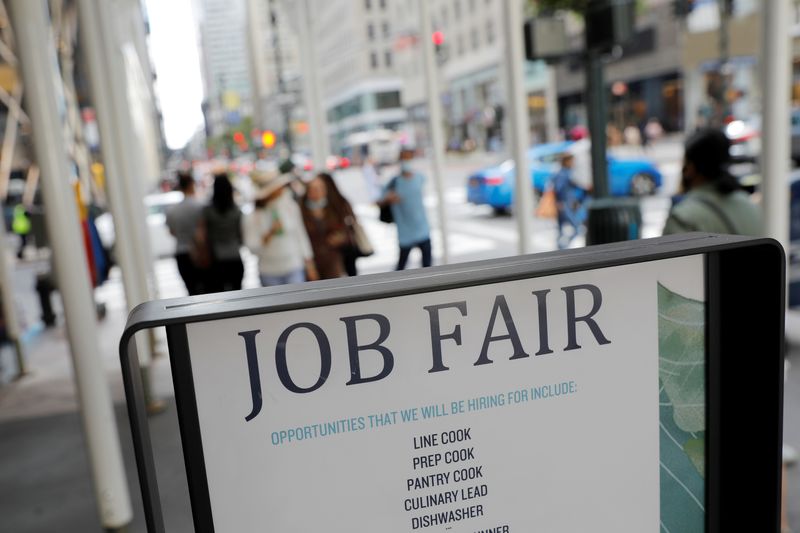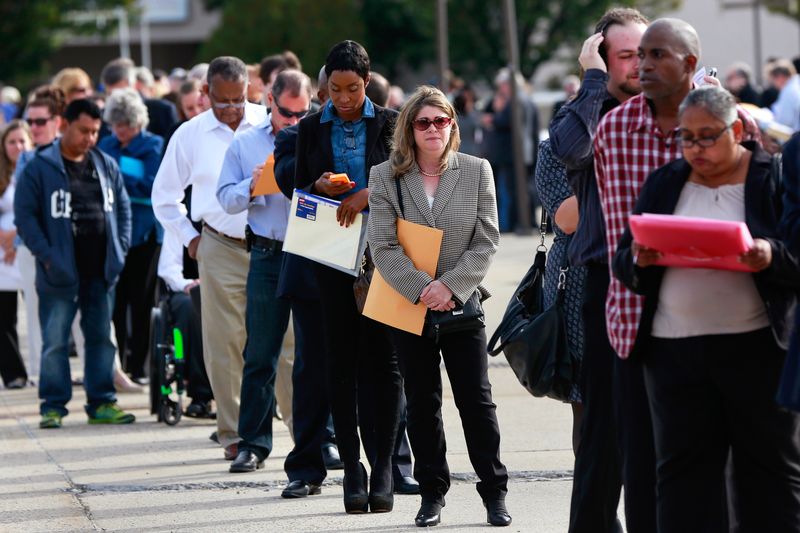By Lucia Mutikani
WASHINGTON (Reuters) -The number of Americans filing new claims for unemployment benefits was unchanged last week as the labor market continued to gradually ease, which could give the Federal Reserve room to wait before cutting interest rates this year.
Despite other data on Thursday showing a sharp widening in the trade deficit in January as businesses boosted imports of computers, semiconductors, motor vehicles and parts, economic growth in the first quarter is expected to slow only marginally as the resilient labor market underpins consumer spending.
"New layoffs are relatively modest and signal that no immediate deterioration of labor market conditions is headed our way," said Christopher Rupkey, chief economist at FWDBONDS in New York. "The trade winds are not blowing as favorably in the economy’s direction at the start of the year, but the consumer is in good shape and their spending is expected to add more to growth later in the first quarter."
Initial claims for state unemployment benefits held at a seasonally adjusted 217,000 for the week ended March 2, the Labor Department said. Economists polled by Reuters had forecast claims unchanged at 215,000 in the latest week.
Claims in New York surged by 14,275 and filings in California increased 6,150. There were also large increases in claims in Texas, but applications dropped by 3,933 in Massachusetts. There were also significant decreases in Georgia, Oregon and Rhode Island.
The labor market is steadily loosening up, which could ease some pressure on inflation. Fed Chair Jerome Powell told lawmakers on Wednesday that the U.S central bank expected "inflation to come down, the economy to keep growing," but shied away from committing to any timetable for interest rate cuts.
There were 1.45 job openings per every unemployed person in January, government data showed on Wednesday. This ratio has dropped from 1.82 a year ago, but remains well above the average of 1.2 during the year before the COVID-19 pandemic.
The Fed's Beige Book report on Wednesday said "labor market tightness eased further," in February but noted "difficulties persisted attracting workers for highly skilled positions."
Since March 2022, the Fed has raised its policy rate by 525 basis points to the current 5.25%-5.50% range.
A separate report from global outplacement firm Challenger, Gray & Christmas on Thursday showed layoffs announced by U.S.-based companies rose only 3% to 84,638 in February. Planned job cuts so far this year are down 7.6% compared to the same period in 2023.
The number of people receiving benefits after an initial week of aid, a proxy for hiring, increased 8,000 to 1.906 million during the week ending Feb. 24, the highest level since last November, the claims report showed.
Stocks on Wall Street were trading higher. The dollar fell against a basket of currencies. U.S. Treasury prices were mixed.
UPCOMING REVISIONS
The Labor Department will next week publish the seasonal factors for 2024 and revised seasonal factors for 2019 through 2023 for both initial and continued claims. It will also revise the data for both series for 2019-2023. Some economists expect these revisions to undo some of the surge in continuing claims seen beginning last September.
The claims data have no bearing on February's employment report due on Friday as they fall outside the survey periods.
According to a Reuters survey of economists, nonfarm payrolls likely increased by 200,000 jobs last month after adding 353,000 positions in January.
The unemployment rate is forecast unchanged at 3.7% and annual wage growth slowing to 4.4% from 4.5% in January.
Some economists have attributed labor market strength to rising worker productivity, which is helping to curb costs for businesses. Nonfarm productivity, which measures hourly output per worker, increased at an unrevised 3.2% annualized rate in the fourth quarter, the Labor Department's Bureau of Labor Statistics said in a separate report on Thursday.
Unit labor costs - the price of labor per single unit of output - rebounded at a 0.4% rate in the fourth quarter.
A third report from the Commerce Department's Bureau of Economic Analysis showed the trade deficit increased 5.1% to $67.4 billion in January. Imports increased 1.1% to $324.6 billion. Goods imports shot up 1.2% to $263.4 billion, with imports of capital goods and motor vehicle parts and engines the highest on record.
While imports subtract from growth, the increase in these two categories bodes well for business investment on equipment.
Exports edged up 0.1% to $257.2 billion. Goods exports nudged up 0.1% to $171.8 billion as the highest capital goods exports on record were partially offset by a decline in crude oil exports.

The data suggested that trade could be a drag on GDP in the first quarter after adding 0.32 percentage point to the 3.2% growth rate last quarter. Growth estimates for January-March quarter are converging around a 2.0% pace.
"How businesses manage their inventories in the months ahead, particularly for durable goods, will remain a wild card for import growth in the year," said Matthew Martin, a U.S. economist at Oxford Economics in New York. "With our expectations for import growth to remain ahead of export growth during the year, net trade is likely to move from a slightly positive to a modest drag on GDP growth."
